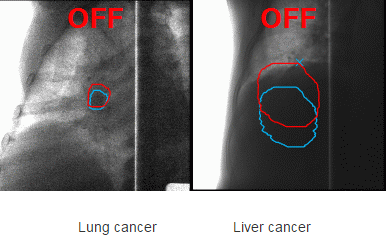Sep 27 2016
Toshiba Corporation and the National Institutes for Quantum and Radiological Science and Technology (QST) have developed a novel tumor tracking technology for heavy-ion radiotherapy equipment that accurately tracks tumor motion caused by respiration. The technology, computational learning based X-ray image processing, is an alternative to the currently most investigated tumor tracking technique, implanting and tracking fiducial markers1 in the patient's body, and is not only non-invasive but accurate to about 1mm. 2 Toshiba aims to commercialize systems equipped with the technology in the next fiscal year. 3
 Applications of the technology Image-guided respiratory-gated irradiation (imaging diagram)
Applications of the technology Image-guided respiratory-gated irradiation (imaging diagram)
Heavy-ion radiotherapy destroys cancerous cells by exposing tumors to a highly accurate carbon-ion beam accelerated to about 70% the speed of light. It reduces treatment times for cancer patients, and the burdens imposed on them.4
In the emerging field of heavy-ion radiotherapy, two methods are attracting attention as a means to track tumors that move with respiration, most notably lung cancers. The most closely studied technique implants fiducial markers in close proximity to the cancerous area and measures their motion as a reference point. The second places sensors on the patient's body surface.5 Both have drawbacks. The markers have to be surgically implanted, imposing a further burden on the patient. Use of the sensors avoids this burden, but at the cost of accuracy. The method developed by Toshiba and QST minimizes the impact on the patient while offering high accuracy tracking.
The technology uses a digitally reconstructed radiograph (DRR) derived from clear 4D-CT image6 of the patient taken before treatment. Tumorous and non-tumorous areas in the image are separated, and a computer learns the features of each area. During treatment, the computer uses these learned features to analyze an actual X-ray image and detect the tumor. The tumor's position can be estimated with an error of about 1mm, with no need to introduce fiducial markers implanted into the body. The technology was developed by combining Toshiba's image processing technology with QST's extensive experience in cancer treatment.
Commenting on the new technology, Mr. Shinichiro Koto, Senior Manager of the Multi Media Laboratory at Toshiba's Corporate Research & Development Center said, "Patient-friendly and highly efficient cancer therapy is a big issue that must be solved. I believe that the fusion of the National Institute of Radiological Sciences (NIRS)' world-class clinical knowledge in heavy-ion radiotherapy and the wide-ranging industrial technologies Toshiba has cultivated over many years in areas including particle beam accelerators and image recognition and processing technologies, can contribute to innovative progress in cancer treatment."
Dr. Shinichiro Mori, Team Leader of Treatment System Research Team in QST, said "NIRS successfully completed the first clinical trials for respiratory gated carbon-ion beam scanning treatment using real-time marker-less tumor tracking in 2015. To improve the marker-less tumor tracking technique, we collaborated with Toshiba and have developed the new technique with a full machine-learning approach."
New Heavy-ion Radiotherapy Technology Tracks Tumors
"Our long clinical and research experience at NIRS has taught us that it can be difficult to introduce new treatment techniques into the clinical workflow. However, based on the results of our studies, we will integrate the new technique into clinical application as commercially available software. The distance from the research stage to the clinic is long, and longer again to other treatment centers. It is an important road, nevertheless, and absolutely worth pursuing. Moreover, it is a more enjoyable road if travelled in company with colleagues both at home and aboard."
Details of this technology will be released on September 26 at the 58th American Society for Radiation Oncology Annual Meeting (ASTRO2016) in Boston.
Toshiba will continue to develop cutting-edge cancer therapy systems, including heavy-ion radiotherapy equipment, with the aim of contributing to high-quality cancer therapy.
QST will promote improvements in treatment precision using the new technology, with a view to promoting the use of heavy-ion radiotherapy.